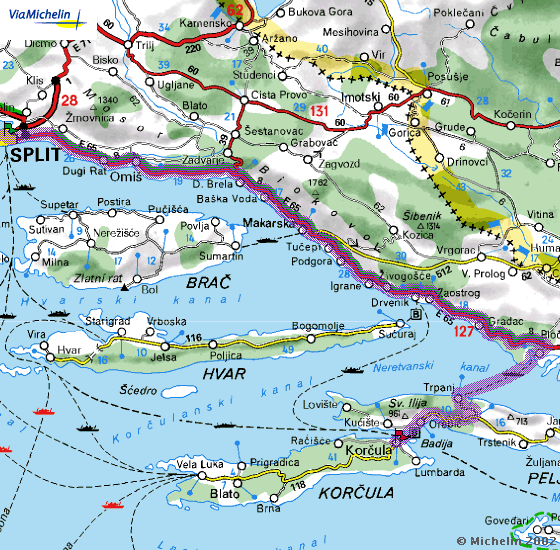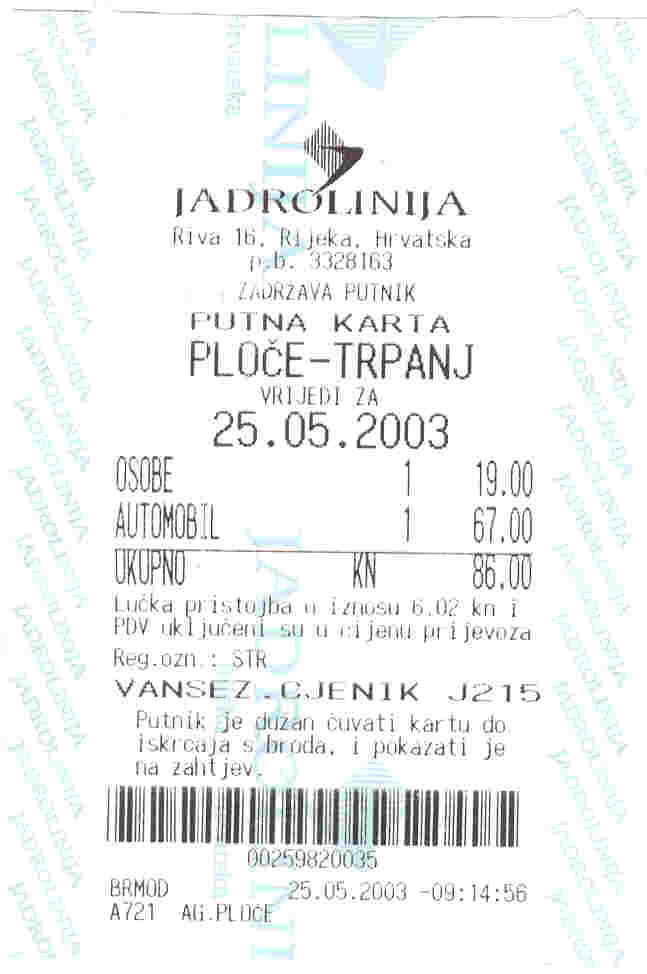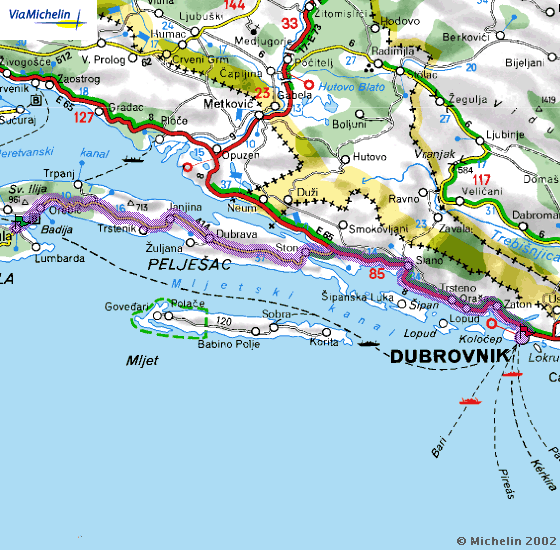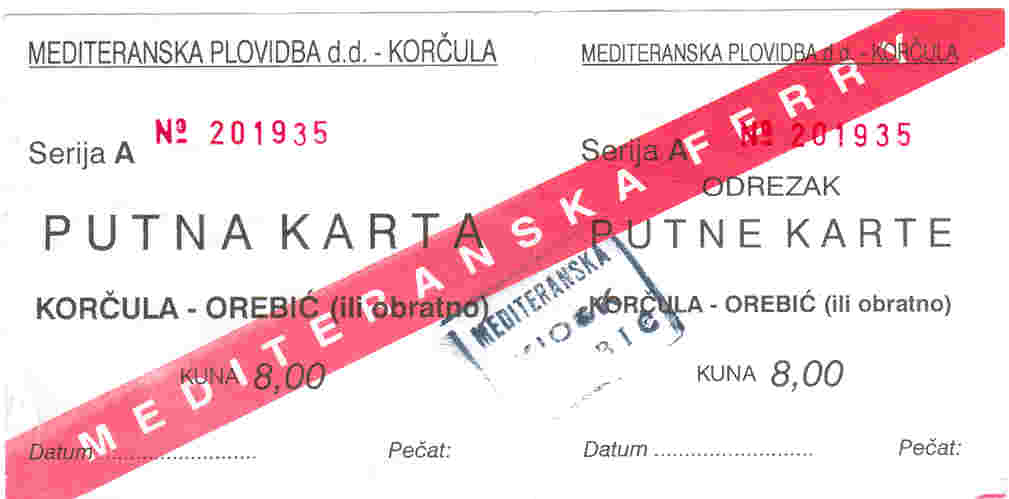Dalmatian Coastal Drive
This was the second of my two drives in Croatia. On this drive, I had planned to visit the island of Korčula en route to Dubrovnik. It would also give me an opportunity to experience the splendor of the Dalmatian coast, which I came to appreciate and love.
Because one detailed map is difficult to place on this website, I have broken the journey into two components: 1) the adventure from Split to Korčula, and 2) the drive from Korčula to Dubrovnik. The map of the first section is included below, while the second is included further down.
Split to Korčula
I left Spilt early Sunday morning in order to make a ferry that was departing
from Ploče at 09.30. Based on the time estimates from the Michelin website
and my rudimentary calculations, I figured that I would have to leave Spilt
around 07.00 in the morning to make the ferry. My route took me along the
upper Dalmatian coast, passing through several towns.

Map courtesy of the Michelin website
The sun was rising over the Dalmatian mountains, which provided a interesting, almost romantic light, for the drive southward. I passed through several towns that still were sleeping off their Saturday evening hangovers. The towns included steel mining town of Dugi Rat, the former pirate hamlet of Omiš and the seaside resort of Makarska. I did stop occassionally to snap pictures of the Adriatic sea and the surrounding countryside.
|
|
|
| Looking south | Some of the most scenic drives I have ever experienced |
|
|
|
| The villages are built into the sides of mountains | The placid waters of the Adriatic |
 The
first stop was Ploče, which is about eighty-five miles southeast of
Split. It is an ugly town with an industrial focus. Its port served
as the main entry point for goods coming into the former Yugoslavia. Its
luster has faded since the federation's demise, and reinventing itself has
proven to be a difficult challenge.
The
first stop was Ploče, which is about eighty-five miles southeast of
Split. It is an ugly town with an industrial focus. Its port served
as the main entry point for goods coming into the former Yugoslavia. Its
luster has faded since the federation's demise, and reinventing itself has
proven to be a difficult challenge.
The town's port is located about two kilometers from the main road. It path to the docks runs past a number of ugly concrete apartment blocks. I reached the port with very little time to spare. My calculations were slightly incorrect, but was able to catch the ferry to Trpanj on the Pelješac peninsula. The ticket office is located in the set of apartment buildings across from the harbor.
A word of caution: allow at least thirty minutes to purchase the ticket and queue for the ferry. I cut it too close!
The ferry service was operated by Jadrolinija, one of many companies transporting cars and passengers between the Croatian mainland and its many islands in the Adriatic sea. To ship me and the Fiat Punto, it cost HRK 86. Boarding the ferry was an interesting challenge, but the car's small size made it easy to wedge into a spot. It took forty-five minutes to complete the crossing, which had excellent views of the main land and the tip of Hvar island to the north.
I unloaded the car and drove from Trpanj on the peninsula's northern shore to Orebić, on the southern shore. The drive was about eighteen kilometers and took approximately thirty minutes to complete. I was trapped behind two lorries, which couldn't pass the 60 kilometer per hour speed limit.
I reached Orebić, from which the second ferry departed. This town is a sleepy hamlet that serves as the primary gateway for travel to Korčula. The port is located near the center of the town, in between a number of tourist spots and the old center. I had decided to leave my car in Orebić, thinking that the ferry would drop me at the center of Korčula. The ticket, therefore was only HRK 8 one-way, a relative bargain.
The ferry between Orebić and Korčula does not drop passengers near the old town, rather it is a six-kilometer walk through some hilly terrain. My recommendation - either take your car to the island or hire one of the taxis that meets the ferry. The walk is a rough one. If you take the car, there is plenty of parking near Korčula's city center.
|
|
|
| The Ston, the Jadrolinija ferry that transported us from Orebić to Korčula | The HRK 8 ticket for ferry transport between Orebić and Korčula |
|
|
|
| Leaving Orebić ... | ... and the destination is in sight! |
|
|
|
| The peninsula town of Korčula | A closer view |
Since the description of Korčula is so large, I have placed it on a separate page. Click here to see the municipality that the Lonely Planet called "... a typical medieval Dalmatian town" (LP3°, 285).
Korčula to Dubrovnik
After completing my adventure in Korčula, I waited about thirty minutes for
a taxi to take me from the town back to the port. Finally, I caught a ride
with a German tourist group, who was nice enough to share their cab with
me. I rode the ferry back to Orebić, retrieved my car and headed to
Dubrovnik. The map below shows the route.

Map courtesy of the Michelin website
For about half of the journey, I traveled on a road that bisected the Pelješac peninsula. This area produces some of the country's finest red wines, a few of which I have sampled. It appeared that every open plot of land was dedicated to some agricultural pursuit, either wine grapes or oil trees. There were a number of small vineyards between Orebić and Trstenik. Ston has a number of impressive 14th c. CE protective walls, some which had been restored.
Though the towns between Ston and Dubrovnik were nondescript, the views of the Adriatic Sea through the passenger window made the drive worthwhile. There is an impressive suspended bridge for entering the northwestern reaches of Dubrovnik, from which the visitor has an excellent view of the city's harbor and docked cruise boats.
Proceed to the Dubrovnik Main
Page or return to the Croatia Main Page
